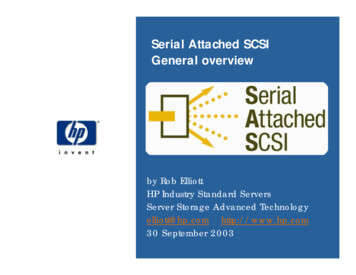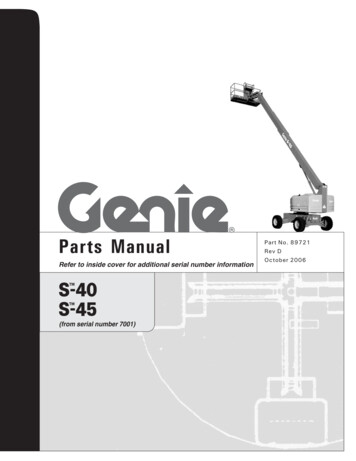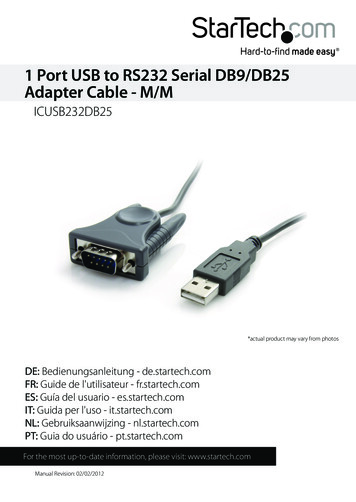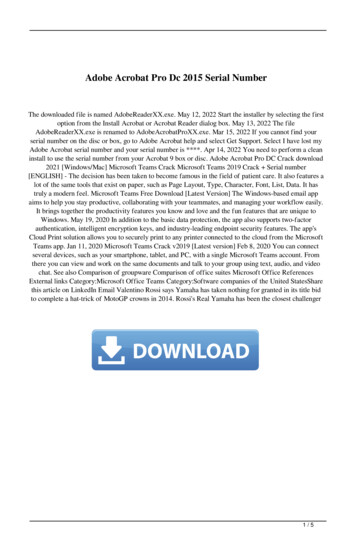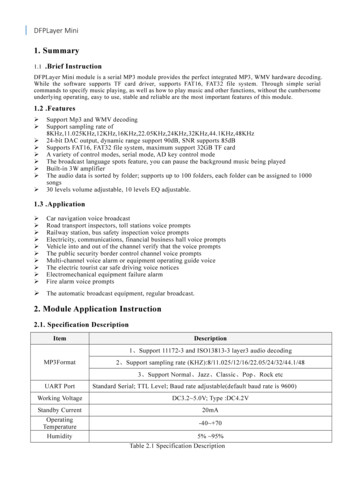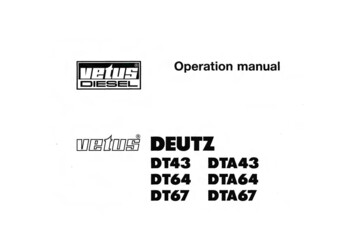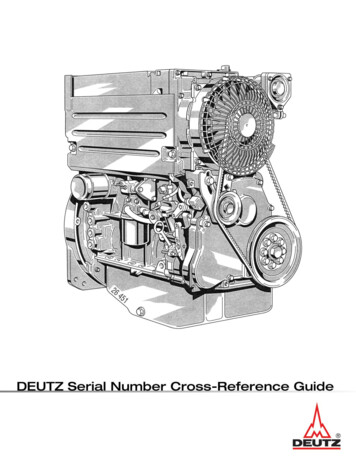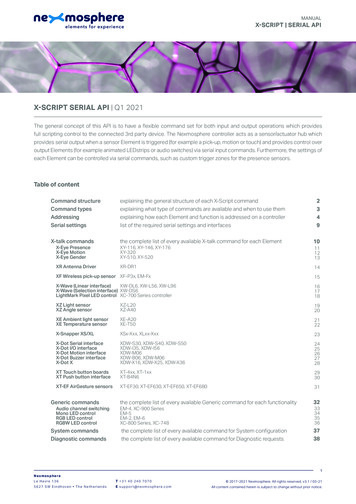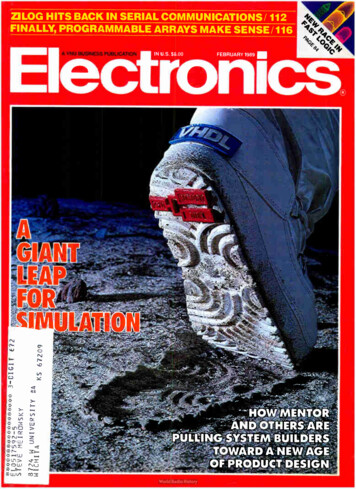
Transcription
ZILOG HITS BACK IN SERIAL COMMUNICATIONS/ 112FINALLY, PROGRAMMABLE ARRAYS MAKE SENSE/116.,., -,4-ee. e e «r. ,.,:e.e. 4MEN1 OR---. -e,-.2»-.-.14 re-eesetz-:.:;:ptte.". ': 4tANDYOTHERedFite4ae'letilj;LINGiSItSTEM BUILDERS e5-- ';ke1--- - - .- 'Nt-f*: TOWARDANEWA . --.---. .,. .GE -tOF PRO APCir.ge.E.SIG, N. .,I?. , .:.0 ., ::eere,,yea.,, - -, r.:›.7
Steel,NASICs have become an integral partof today's automotive products.Improving performance.Increasing reliabilityEnhancing driver safety and convenience in ways unimaginable justafew years ago.In this very demanding industry onthe most unforgiving provinggrounds, NCR has earned an enviable reputation for first-pass success,responsive service and high qualitySmart FET DriverUses on-board analog functions to addsmart FET driving capability withopen/short failure detection and includesonchip voltage doubler.Design Turn: 18 weeks.Fluid Level SensorMixed mode device interfaces withdashboard display, includes precisionon-board analog to eliminate falsereadings from sloshing fluids.Design Turn: 16 weeks.Today, we have asolid track-recordof successful ASIC programs withall the major U.S. automotive corporations spanning initial design tohigh volume production— including "Just In Time" delivery anddock-to-stock QA programs.And NCR design tools are becoming the choice of fast-track ASICdesigners. With NCR DesignSynthesis- and Design Advisor expert system, designers can spendmore time creating, less timebogged-down in minute details.To kick the tires on our automotive,commercial and military ASIClibraries, call today: 1-800-334-5454.NCR Microelectronics, 1700 SouthPatterson Blvd., Dayton, Ohio 45479.Distributorless Ignition ChipPart of integrated engine developmentprogram that helps improve engineperformance up to 40%. Integrates keyanalog and digital functions into asingle, compact, high-reliability CMOSdevice.Design Turn: 26 weeks.
Style & Silicon.Electronic Instrument ClusterMixed mode system-on-a-chipreplaces traditional 2- to-3chip discreteimplementations. Includes a68HCO5microprocessor core, plus memory,analog functions and digital glue logic.Design Turn: 26 weeks.Light Controller ChipSingle chip solution includes all thedigital, analog and memory functions tocontrol headlights, parking and foglights. Provides exit delay timer andallows manual control of exterior lightsfrom driver door.Design Turn: 14 weeks.111.1. Keyless EntryChip contains EEPROM supercell thatprovides direct write capability forflexible security code generation. Tenyears data retention and 10,000 read/write cycles for harsh automotive environment. Can be configured fir dual orsingle supply programming.Design Turn: 14 weeks.1989 NCR Corporation. Design Advisoi and Design Synthesis are trademarks of NCR Corporation.Circle 1
AraAWARNING!RE»MANUAL BEFOREUSE.SIMPSON UNIVERSAL FREQUENCY COUNTERS.COUNT ON US FORACCURACY.Simpson's new high precision,eight digit frequency countersgive you an eye into the worldof critical clock signals. RF oscillators and data communications.taken on complex and noisywave-forms by using the variabletrigger controls and built-in, lowpass filter. One model even offersyou selectable attenuation andReadings of frequency ( to 1.3GHz), frequency ratio ( A/B),period, time interval ( A to B) andtotalized count combined withmulti-channel triggering let youfind circuit problems that mightotherwise go unnoticed.AC/DC coupling, allowing theinputs to accommodate arangeof signal characteristics. For morecomplex measurement situationsinvolving two interdependentfrequencies, an external clock canbe substituted for the internaloscillator. This feature enables youto investigate awide spectrum offrequencies—from computer circuitry to satellite communications.Try the new lineup of Professional Series frequency countersfrom Simpson. It all adds up toaccuracy and reliability.Simpson's Professional Seriesfrequency counters allow foraccurate measurements to beamIne immak àzSimpson Prote%mortrii Sent-,product' , tre made irt USASimpson Electric CompanyCircle 2853 Dundee Ave., Elgin, Illinois 60120-3090 312/697-2260FAX: 312/697-2272
ElectronicsUP FRONTCAN HARDWARE ARTISTS LEARN TO CODE?EDITOR-IN-CHIEFRobin NelsonThe new era of product design will havehardware people doing something suspiciouslylike programming—and many may resistEXECUTIVE EDITORSJeremy YoungBenjamin A. Mason (Special Projects)MANAGING EDITORHoward WolffHI've been called awirehead myself, and taken it as acompliment, too. But I've also dabbled in software, just to see.The time has come, however, for hardware-oriented wirehead engineers to do more then dabble in code. You've heard it before:hardware is software. This time it's coming true, though—hardware design is fast becoming acoding exercise. Engineering workfor most circuits above the transistor level can be done by writinglines of code that look just like lines of Cor Ada.It wasn't hard to predict, as computer-aided engineering grew inpopularity, that eventually the computers would give up the pretense of being drafting tables and demand to be fed not diagramsbut modules, procedures, lines of code. Now the hardware-is-software crowd has gotten together on alanguage standard: VHDL.(That's V as in VHSIC, for the Pentagon's Very High Speed Integrated Circuits program, and HDL for hardware description language.) Last year the IEEE set its stamp on aversion of the DODmandated language, and now CAE's biggest gun, Mentor GraphicsCorp., San Jose, Calif., has jumped into the game (see p. 77).It's time for hardware engineers to start learning to write VHDLcode. There are very few now who can, say participants in the stillsmall VHDL-simulator market. Some observers are very doubtfulabout the ability of most system engineers to make so radical achange in their way of thinking. Vantage Analysis Systems Inc. ofFremont, Calif., for example, has gone to great lengths in its VHDLsimulation product to hide the language from the user. Vantage'ssimulator presents him with familiar schematic views and alibraryof VHDL function models. If he should need anew one, says Vantage, he'll commission it from specialists.The approach would appear sensible at atime when next to no engineers are competent in VHDL, and while satisfying Uncle Samwith VHDL documentation is the main aim. But in the long run, Mentor's courageous position promises the industry abigger payoff.Mentor's new VHDL tools draw the CAE user into the language; toget any real leverage from them, the user must learn how to writecode. But once he does, he can do things he never did before. He canplay around with simulations of his system using high-level behavioral descriptions, finding flaws and bottlenecks in an architecturebefore fixing them means murdering the schedule.The people at Mentor know that there's but ahandful of engineers who can use their tools; that's why they're setting up abigtraining program. Until engineering schools get geared up, Mentormust educate every new user. It's going to be ahard row to hoe.It is agiant leap. Many engineers won't make it. But I'm convinced that system builders who move fast to build acadre of VHDLliterate engineers will win avaluable time-to-market edge. Tell yourwireheads asecret: writing code can be fun!JEREMY YOUNGEDITOR-AT-LARGESamuel WeberSENIOR EDITORSBernard C. Cole, Tom Manuel,Jonah McLeodDEPARTMENT EDITORSComponent Technology:Bernard C. Cole (San Jose)Communications:Jack ShandleComputers & Software:Tom ManuelIndustrial & Consumer Markets:Wesley R. Iversen (Chicago)Military & Aerospace Markets:Tobias Naegele (Washington)System Technology:Jonah McLeod (San Jose)NEWS ANALYSISHoward Wolff, Larry KingEDITORIAL PRODUCTIONCharles D. Ciatto (Manager)Elsa M. PecoroniCOPY EDITORSJacqueline Damian (Chief)Mary K. CaulfieldARTMark Montgomery (Associate Director)Janet Kroenke (Technical Illustrator)NEWS BUREAUSWest Coast Executive Editor:Dave Bursky (San Jose)Boston: Lawrence Curran, ManagerChicago: Wesley R. Iversen, ManagerLos Angeles: Larry Waller, ManagerMid- Atlantic: Jack Shandle, ManagerWashington D.C. : Tobias NaegeleTokyo: Charles L Cohen, ManagerFrankfurt: John Gosch, ManagerUK Correspondent: Peter FletcherEDITORIAL DIRECTORStephen E. ScrupskiEDITORIAL PRODUCTION DIRECTORAnne Gilio TurtoroGROUP ART DIRECTORPeter JeziorskiEDITORIAL ADMINISTRATIONTina A. MontoneDirector of Sales: Tim L TobeckRegional Sales ManagersJohn R. Carroll ( East/Midwest)Thomas A. Conway Jr. (South/Southwest)Director of Circulation: Barbara FreundlichManager of Circulation: Cindy StumpReader Service Manager: Paula GreenleafProduction Director: Aldo F. UllioVNU BUSINESS PUBLICATIONS INC.President: Robert J. LydonGroup Publisher: Paul MazzacanoPublisher: James C. UhlElectronics/ February 1989February 1989Volume 62. Number 2108.608 copies of 0115 Issue pooledElectronics ( ISSN 0883-4989). Published monthly by VNU BusinessPublications Inc. Publication office. Ten Holland Drive, Hasbrouck Heights.N. J. 07604. second class postage paid at Hackensack. N. J. 07602 andadditional mailing officesExecutive. editorial, circulation, and advertising addresses: Electronics,Ten Holland Drive, Hasbrouck Heights. N. J. 07604 Telephone (201) 393.6000. Facsimile ( 201) 393-6388. TWX 710-990.5071 ( HAYDENPUBHBHT) Cable Haydenpubs.Title registered in U. S. Patent Office. Copyright 1989 by VNU BusinessPublications Inc. All rights reserved. The contents of this publication maynot be reproduced in whole or in part without the consent of the copyrightWhere necessary, permission is granted by the copyright owner forhbranes and others registered with the Copyright Clearance Center (CCC).21 Congress Street, Salem, Mass 01970, to photocopy any article hereinfor for a fee of 5.50. Payment should be sent directly to Inc CCCCopying done for other than personal or internal reference use without theexpress permission of VNU Business Publications Inc. is prohibitedRequests for special permission or bulk orders should be addressed tothe editor. ISSN 0883.4989/89 SO 50 , . 25.For subscriber change of address and subscription inquiries, call215-630-4277.POSTMASTER Please send change of address to ELECTRONICS,P.O. Box 1092. Southeastern, Pa 193983
Fl3RUART 19119ElectronicsNEWSLETTERSFEATURESElectronics, 17 A graphics system for Apollo'sdesktop supercomputer, finally Here's apeek at Motorola'smicrocontroller plans OSF delivers auser-interfacetechnology—and it's on timeCOVER A giant leap for simulation, 73Products to Watch, 23 Heurikon's VME board does bitblock transfers twice as fast asthe competition Data-compression softwaredoubles capacity of quarter-inchtape drives Data General shifts osiinteroperability into high gear A 32-megaflops compute serverfor Macintosh networks arrivesWashington Insider, 65 Equipment makers are asked tostimulate U. S. DRAMproduction. . and, with chip makers, mayhave anew solution for pricing Will Congress take on some riskin the HDTV gamble? Regulating DOD consultants:how much disclosure is enough?Pacific Rim Trends, 69 NIT reports dramatic advancesin optical data transmission A new Japanese consortiumplans to develop fuzzy computers IBM and DEC subsidiaries inJapan get afoothold with NITsponsored projectEuropean Observer, 71 Europeans hammer out thefinancial details for Jessi Another alliance: Siemens buysmajority share in France's IN2 Intermetall's new audio chip setlures amajor U. S. carmaker4CAE vendors are pulling system builders toward VHDL, thehardware description language spun out of the DefenseDepartment's Very High Speed Integrated Circuits program;design simulation will never be the same Mentor Graphics bites the VHDL bullet, 77The language is the centerpiece of its new CAE strategy Gateway's simulator improves its timing, 80It's working on aVHDL strategy; in the meantime, the company isrolling out ahigh-speed timing analysis toolThe new race in fast logic, 84Fast integrated circuits are no longer enough in the ECL arena;now ICs have to offer lower cost, higher density, better noiseimmunity, and lower power consumption—which is why GaAs,cmos, and bicmos chips are appearing in Ecircompatible form Aspen shows biCMOS can yield fast static RAMs, 88 Synergy taps isolation instead of shrinking geometries, 89 Raytheon boosts density in a2.0-micron process, 90 Vitesse's gallium arsenide equals ECL's density, 92In fiber optics, the battle to close the local loop begins, 94Phone companies vie with cable-Tv firms to string lines linkingcustomers with local branch exchangesArrays of disk drives break the data-transfer logjam, 97Parallel-processing architectures for disk subsystems could boostdata-transfer rates enough to match high-speed processorsThe high-performance son of SCSI is coming soon, 104After seven revisions, the SCSI-2peripheral-interface standard isabout to emerge, and products are comingHunting for opportunities in the rebuilt space program, 108NASA is back on its feet, but that doesn't mean the money is flowingfreely—most of it is going to entrenched programsZilog hits back in serial communications controllers, 112The once-dominant supplier hits the market with anew line ofgeneral-purpose controller chipsA one-chip solution boosts high-end desktop graphics, 114Inmos's video controller puts work-station-quality graphics onbusiness users' machinesFinally, programmable arrays make sense, 116Data i/o's new tool speeds in-circuit verification and debuggingEXECUTIVE BRIEFING: Cellular phones are going digital, 120Some systems are hitting capacity; digital technology is the answerElectronics/ February 1989
VOLUME 62, NO. 2COJER.AEOPROBING ENE NEWSGovernment, 29How will technology fare underthe Bush administration?Important budget decisions areon the wayTakeovers, 31The GEC-Plessey duel:jousting for companies, withmajor markets in the balanceCommunications, 37Why AT&T and Intel are teamingup on ISDN and twisted-pairEthernetsRobotics, 39It may get easier to programrobots off line, thanks to theefforts of the Robotic IndustriesAssociationWork stations, 49DEC lets the RISC genie out of thebottle—and poses achallenge toSun MicrosystemsMilitary, 53Renewing aresource:old parts spring anewInstruments, 58The fastest microprocessorswon't faze this emulatorPAGE 73COMPANIESDEPARTMENTSInfotron Systems Corp., 128The telecom vendor is going forthe gold overseasUp Front, 3Hardware people are going to dosomething that looks suspiciouslylike programming—whether theylike it or notIIS Inc., 129Israeli firm beats the big boyswith R&DApricot Computers, 130This microsystem maker likesanonymityMultiflow Computer Inc., 131Shed no tears for MultiflowInteractive video, 57Digital Video Interactive may beprogrammers' next gold mine, ifthey can learn some new tricksConsumer, 60The gray market is open fordigital-audio-tape machinesPEOPLEJames D. Bowen, 132Indicators, 124Where Air Force research fundsare goingBook Review, 125How secure is Unix?You'd be surprisedManagement Edge, 126Is Rockwell's Bowen the new lookin IC executives? A chipequipment expert takes on theSemiconductor Products Division High-tech companies finally gohigh tech Interested in modernmanufacturing? See it in actionDavid A. Hytha, 133Readers Report, 135AT&T's Hytha is ready to sellchips in JapanRobert Johnson, 133A commodities man turns to ASICsElectronics/ February 1989Letter from Arizona, 8They're doing some serioussoul-searching in the Cactus StateUpdate, 140Alliant FX minisupers arewinners—and the company surelycan use them5
Seventeen MIPS withasingle 32-bit RISC chip. Shrinkwrapped development softMIPSNow.ANSI Coptimizingcompiler by Metaware. Assemblers by Microtec. Architecturalsimulators. Hardware debugmodule by Step Engineering.17 MIPS5MIPS29K25MHzPerformanceNow"1Advanced Mic
64All available from Aivip,Behavioralmodels from Logic Automation. Real time OS by ReadySystems. Logic analyzer interfaces from HP And more.Remember why youwanted to be an engineer?This is why. 5229K25MHz809450KB2QMkéRero Devices' 29KCall toll free ( 800) 222-9323. Advanced Micro Devices. Inc. 901 Thompson Place, P.O. Box 3453, Sunnyvale. CA 94088.eCircle 5CI989 Advanced Micro Devices. Inc
PICOLETTER FROM ARIZONAULTRA- MINIATUREDC-DeConvertersLow Profile .5 x.5 x.3 ht.o4eActual-SizeIVERY0 ONE WEEKSTOPICO's high reliability DC-DCConverters are produced in anultra-miniature encapsulatedpackage (. 5" x . 5" x . 3" ht.).Over 80 different models operating over the temperature rangeof - 25 C to 4- 70 C ambientwithout deratng. 16 new high voltage models100-250 volt output Up to 1.25 watt output at-25 C to 70 C ambient Ultra- miniature size (0.3 Height) 5 input voltage ranges 5, 12, 24, 28and 48V DC 28V Input/Output now standard Input/output isolation100 megohm @ 500V DC Single and dual output No heat sink requiredI OPTIONS AVAILABLE Expanded operating temp(-55 C to 85 C ambient) Stabilization Bake (/ 25 C ambient) Temperature Cycle (- 55 C to 125 C) Hi Temp, full power burn in(100% power, 125 C case temp)Over 500 miniature lowprofilestandard models deliverup to 20 watts power.PICO also manufactures over 2500standard ultra- miniature transformersA BAD YEAR MAKES ARIZONASEARCH ITS HIGH-TECH SOULPHOENIXAfter four decades of steadygrowth, Arizona's electronics industry hit some snags lastyear. Now executives and government officials around thestate are wondering if the setbacks were precursors oftough times to come in the years ahead.The first of two major disappointmentscame early in 1988 when Sematech, the industry's manufacturing research consortium, chose Texas over Arizona (and theother contenders) as the site for its headquarters and research facility. Then, inNovember, the federal government decided not to base its superconducting-supercollider project, amammoth programslated to last for the next decade, in thestate. The winner, again, was Texas.The Arizonan dismay was exacerbatedby overly optimistic expectations. Manyof the state's industry figures and politicians believed they would land one orboth projects. Some of them still cling tothe notion that Texas won out throughunderhanded politicking.Besides losing the plums they hoped toget, Arizona's electronics executives alsolost some things they already had. Thesemiconductor market slumped and defense-related orders dropped in the second half of 1988. And in acrowning blow,IBM Corp. announced that during 1989 itwould take some 2,800 jobs away from itsmainframe plant in Tucson and consolidate them in aplant in San Jose, Calif.STILL morn But the setbacks of 1988 donot mean the electronics industry in Arizona is on the brink of disaster. Despite them,it remains very healthy. Statewide statistics are hard to come by, but the Arizonacouncil of the American Electronics Association estimates that revenue from aerospace and electronics was about 6billionlast year, which means they've doubledsince 1982. Total employment in the indus-IT'S CHEAPER IN ARIZONASOUTHERN CALIFORNIA& inductors.Delivery—stock toone weekPICOElectronics, Inc.453 N. MacOuesten Pkwy. Mt. Vernon, N.Y. 10552Call Toll FreeNEW YORK CALL8800-431-1064914-699-5514Circle 210}try reached some 70,000 people,about half of Arizona's manufacturing jobs, with an annual payroll of about 1.9 billion. Electronics has now, for the firsttime, leapfrogged tourism andconstruction in annual revenue.Such growth is what Arizonahas come to expect ever since World WarII. The first high-tech companies startedmoving in then, lured by the climate andthe state's ferociously pro-business environment. General Electric, Hughes Aircraft, Motorola, and Sperry were amongthe first; since then, they've been joinedby other giants like Honeywell, IBM, andIntel, plus ahost of smaller companies.The climate and the pro-business attitude remain potent lures. Added to themis afavorable economy, one that benefitsboth employers and employees. The costof doing business is some 20% cheaperthan it is in Southern California, according to an Arizona Department of Commerce study. Similarly, ahouse in Arizona costs less than half the price of acomparable house on the West Coast.The year-round sunshine, healthy economy, and laid-back lifestyle have attracted acompetent and stable labor force.Few people who put down roots everleave, says Richard G. Loeb, chairman ofOptifab Inc. in Phoenix. He tells the occasional defecting employee, " you'll beback." The same holds true for companies: those that have established themselves seldom leave. Generally, they expand. Motorola, for example, is puttingits world-class MOS 6dynamic-randomaccess-memory facility in Mesa, an investment representing upwards of 100million. And Intel continually stepped upactivities at its Chandler complex duringthe recent chip boom.But the events of last year made industry executives aware that they couldn'trely on the natural advantages of Arizo-ARIZONAL.A./Long BeachMetro AreaSanto Ana/Newport/IrvineEstrella/PhoenixTotal labor costs10.710.19.2Electric ' ANNUAL GEOGRAPHICALLY VARIABLE OPERATING COSTS IN SMILLIONSSOURCE: ARIZONA DEPARTMENT OF COMMERCEElectronics / February 1989
—Fred Molinari, PresidentWhen it comes to high performance data acquisitionfor the PS/2,we're the only act in town.Abold claim that happens to be true.It's our all new DT2901 Analog andDigital I/O Board for the IBM PS/2. We say"all new" because we developed our boardfrom scratch, unlike other developers whohave been content to simply modify their"old designs:'So, how does that make our I/O boardbetter?We built our board around twocustom-designed chips. Our data transferchip permits A/D, D/A and Digital I/0operations to occur simultaneously andwithout data gaps. Our custom MCA Interface Chip does the work of severalconventional chips, permitting high performance operation while saving valuablespace and power.Add to this its fast 50kHz throughput,flexible channel and gain selection, andyou've got yourself performance like noother data acquisition board on the markettoday.You can get all of this, including ourFREE ACQUIRE software, for under 1,000!Think about it, and we think 6SE/8DI12 bits1,2,4,8,1650kHz2chans.12 bits50kHz/chan.16 lines28995DT290516SE/8DI12 bits1,2,10,20100,200,500,100050kHz26k Hz2chans.12 bits50kHz/chan.16 lines2 10 95Modelagree . our all new high performance I/Oboard isn't just the only act in town, it'salso the best.So act now.Call (508) 481-3700In Canada, call (800) 268-0425.FREE 1988/89 Data AcquisitionHandbook.PriceDATA TRANSLATION World Headquarters: Data Translation, Inc., 100 Locke Drive, Marlboro, MA 017521192 USA, (508) 4813700 Ti 951646United Kingdom Headquarters: Data Translation Ltd., The Mulberry Business Park, Wokingharn. Berkshire RG11 2Q.1, U.K. (0734) 793838 Tlx 94011914West Germany Headquarters: Data Translation GmbH, Stuttgarter Strasse 66, 7120 Bietigheim-Bissingen, West Germany 07142-54025International Sales Offices: Australia (2) 6624255; Belgium (2) 735-2135; Canada (800) 268-0427:Chile (2) 251689; China (408) 7278222, (1) 868-721; Denmark274511; Finland (90) 372144; France (1)69077802; Greece951-4944, (31) 527.039, (1) 361-4300; Hong Kong (5) 448963; India (22) 211040; Israel (3) 5401524; Italy (2) 82470.1; Japan (3) 348-8301, (3) 5a2-5550, (3) 3551111; Korea (82) 756-9954;Morocco (9) 304181; Netherlands ( 70) 99-6360; New Zealand (9) 504759; Norway (2) 53 12 50; Peru (14) 31-8060; Philippines 818-0103; Portugal 545313; Singapore 7797621; Sou:Ulna (12) 8037680/93; Spain455-8112; Sweden (81 7617820; Switzerland (1) 7231410; Taiwan (2) 9184740; United Kingdom (0734) 793838; West Germany 0714294025.Data Translation is aregistered trademark of Data Translation, Inc. All other trademarks and registered trademarks are the property of their respective holders.e)a)(1)Circle 9
NINE MONTHS FROM CONCEPTTO FINISHED PRODUCT.Matty GoldmanBaby Girl8Lbs., 2oz.Natural Childbirth2SistersSchlumberger needed abig chip. Theyneeded it in abig hurry. And they neededit to work the first time.Thanks to VLSI's Datapath Compiler andLogic Synthesizer, they got what they needed.Our ASIC tools let them design at ahigh level. And in just four short months,Schlumberger had adata processor for amil std 2179 recorder that packs 385,000transistors in 460 square millimeters.That's one big baby.C) 1989 VLSI Technology, Inc. Baby Photo The Image Bank—Averara, 1989.OUR LIBRARIES EASE THEGENERATION GAP.Once you design achip with VLSI, ourPortable Library"' icons let you slide rightinto your next generation chips.You can add new features, or try our new1-micron CMOS technology for high-speed,high-density designs.You can choose cell-based or gate arraychips. You can take advantage of thecustom foundry services at our new Class 1
FOUR MONTHS FROM CONCEPTTO FINISHED PRODUCTSchlumbergerData Processor for Mil Std 2179 Recorder68-pin Ceramic Pin Grid ArrayCell-Based, 1.5-Micron CMOS385,000 Transistorswafer fab in San Antonio, Texas.You can even switch to Gallium Arsenideor radhard CMOS and keep most of youroriginal design work.WE WEREN'T BORNYESTERDAYVLSI Technology has produced morehigh-integration cell-based CMOS ASICdesigns than anyone else. We're not strangersto gate arrays, either.We can help you through every step ofyour design at one of our many ASICTechnology Centers around the world.Call 1-800-872-6753. Or write us at 1109McKay Dr., MS32, San Jose, CA 95131.We will help you design the ASIC youwant faster than you ever thought possible.More importantly, we'll do it faster thanyour competition ever thought possible.And isn't that an interesting concept?OVLSI TECHNOLOGY, INC.Circle 11
PICOtransformerssmall sizembig spL„.„11/ size variations of . 25" dia. x.25" to .75" dia. x 82" ht. MIL- T- 27E (PICO is QPL source) 20Hz —250KHz pulse applications . 05µs to 100µs prim, and sec. impedances2 ohms to 250K ohms power to 3 watts inductors to 80 henries plug-in construction, surfacemount, or flying leadseextreme resistance to thermalshock MIL- STD- 202F, method107(25 cycles). Special designsfor 300 cycles.Delivery—stock toone weekPICOElectronics, Inc.453 N MacOuesten Morey. Mt. Vernon, N.Y. 10552Call Toll Free 800-431-1064IN NEW YORK CALL 914499-5514PICO also manufactures over 500standard DC- DC Converters and over2500 Miniature Transformersand inductors.12Circle 211na to guarantee continued growth. Instate development plan is unveiled soon,fact, anumber of them had already comeas promised, its fate will be determinedto that conclusion; 1988 simply added a by who's behind it. " Watch for thesense of urgency to plans they werenames," says one executive. " If it's thestarting to make.same old vested interests in banks andThese executives belong to aloosely orreal estate, then it won't work."ganized network revolving around theIn short, Arizona does not have an efstate AEA council. They have set themfective "old-boy network," that confederselves an ambitious task: to define theiration of bankers, industry heavyweights,goals for growth and how they can bestreal estate interests, and old money thatreach them. The group began its workmakes things happen. Rather, it runs on awhen the members started to realize that frontier mentality, says R. Dale Lillard,some kind of statewide planning couldn't the president of Lansdale Semiconductorbe put off any longer. "We're at adecisionInc. in Tempe. "This remains avery conpoint—how we mature," says Terry Bibservative state."bens, chairman of the council and aseniorNO WONDER. Given the prevalent attivice president at Loral Corp.'s Defensetudes, says one observer, it's no wonderSystems in Litchfield Park.Arizona lost Sematech and the colliderThe first concrete action focuses on the project. "It is painfully obvious that Aristate legislature—the group is trying tozona is not yet in aposition to attractget it to set up ahigh-tech committee that these world-class projects," says Waltercan help guide state policy. "We recog- J. Schuch, editor of the Southwest Technize that companies will come and we'llnology Report, awidely read newsletter.get growth, no matter what," says Opti- Texas, by contrast, "has statewide depthfab's Loeb. " The trick is to manage itin technical and scientific competence; itrather than react to it."has a stable, broadPart of the problem isbased, high-tech industhat years of easy Can the state shake its try; and it has strong logrowth have made the frontier mentality to start cal financial resources.state's leaders complaArizona does not."cooperative planning?cent, agrowing numberFinances are aparticof executives think. Exular sore point for highperience in states liketech businesses, espeTexas and Massachusetts shows that cially the startups and small companies inlanding Sematech-type projects demandsneed of local financing. The problem liesawell-organized, well-financed effort with Arizona's bankers. They are for thethat draws on the resources of the entiremost part aplay-it-safe breed, who neistate. By all accounts, nothing of this sort ther understand high-tech businesses norhas ever happened in Arizona. Unlike a appreciate their importance to the state.number of other states, Arizona has no They prefer real estate loans, industryhigh-tech advisory groups.veterans say.The setbacks therefore also jolted at"If you don't go in there pushing aleast one state agency, Arizona's Departwheelbarrow, you come right back out,"ment of Commerce, whose charter insays David R. Buchanan, aveteran startcludes luring new industries. The departup and venture-capital executive who isment just didn't have amechanism inpresident of Three-Five Systems Inc. inplace for coordinating the state's majorPhoenix.players, says its director, David P. JanThe bankers' tunnel vision exemplifieskofsky. That's always been aweakness,amore general lack of appreciation forhe says, and last year it proved disastechnology,
general-purpose controller chips A one-chip solution boosts high-end desktop graphics, 114 Inmos's video controller puts work-station-quality graphics on business users' machines Finally, programmable arrays make sense, 116 Data i/o's new tool speeds in-circuit verification and debugging EXECUTIVE BRIEFING: Cellular phones are going digital, 120
